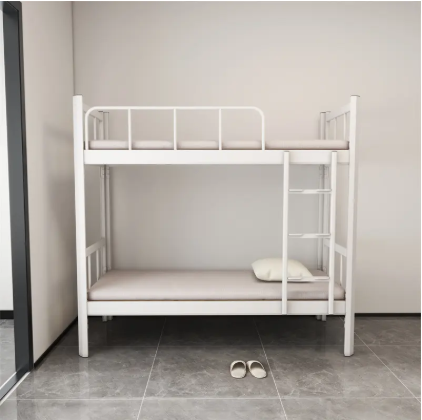Falls from Height: Preventing Serious Injuries
Guardrail Requirements for Upper Bunks
Putting guardrails on those top bunks really matters if we want to stop kids from falling out of their beds at night. The rule about making sure they stick out about seven inches above whatever mattress is being used isn't just some random guideline either. Safety groups including the CPSC have looked into this stuff quite a bit, and what they found? Guardrails work pretty well against fall accidents. One particular piece of research actually showed that getting these railings installed correctly could cut down on those mishaps by around thirty percent. There are plenty of options available too - some stay put all the time while others come off easily depending on how the bed gets used day to day. What matters most though is that whatever design parents choose ends up doing its job properly so everyone sleeps better knowing their little ones won't tumble down during the night.
Proper Mattress Alignment and Gap Prevention
Getting the mattress to fit properly inside the bed frame matters a lot because otherwise there might be spaces big enough to catch little fingers or toes. When a mattress doesn't match up with the height of those side rails, it leaves kids vulnerable if they roll over during sleep. Most safety guidelines suggest looking for mattresses that stick out about six inches past the edges just in case things shift around overnight. Checking the mattress fit regularly makes sense too since fabric stretches and springs sag over time. Safety experts always stress this point when talking about bedroom setups for young children.
Ladder Safety and Secure Climbing Practices
Having a solid ladder properly positioned is really important when kids are using bunk beds because it helps stop accidents when they go up or come down. The ladder needs to stay firmly in place on the bed frame so it doesn't move around or fall off somehow. Kids should grab onto both sides of the ladder with their hands and face forward while climbing, just like how adults would do it safely. Most safety experts agree about this stuff, and many parenting websites actually recommend teaching little ones good climbing techniques from an early age. When families follow these basic safety rules, children generally feel much more comfortable sleeping in upper bunks without worrying about getting hurt during bedtime routines.
Entrapment Hazards: Addressing Head/Neck Risks
Safe Guardrail Spacing (Under 3.5 Inches)
Getting the spacing right on those guardrails matters a lot when it comes to keeping kids safe from head and neck injuries. The rules say there should be no more than 3.5 inches between the bed frame and the bottom rail, something the Consumer Product Safety Commission backs up pretty strongly. Dr. Paul Roumeliotis, who has spent decades working with young patients, often talks about how important this gap is after seeing too many cases where kids got stuck and couldn't breathe properly. Parents need to check those rails regularly because hardware does tend to loosen up over time with regular use. Just making sure those measurements stay within limits can really cut down on accidents, which means peace of mind for families setting up bunk beds at home or in daycare centers.
Wall Gap Dangers and Protective Barriers
Those spaces between bunk beds and walls or furniture aren't just annoying little nooks they actually pose real danger for kids getting trapped. Little children in particular tend to squeeze into these areas and end up stuck, which could lead to serious problems like breathing difficulties or even broken bones. Parents should consider installing guardrails or foam padding along these gaps to keep them safe. Safety studies show that most accidents happen when there's not enough space between the bed frame and surrounding structures. Putting in those protective measures makes a big difference though, cutting down on accidents significantly. Most child safety experts recommend this extra precaution for families with young ones sleeping in upper bunks.
Mattress-Frame Fit to Prevent Body Entrapment
Getting a mattress that fits just right in a bunk bed frame isn't just about comfort it's actually pretty critical for avoiding situations where someone gets stuck. When the mattress doesn't match up properly, those gaps between the mattress edge and the frame can become real hazards. We see this happen often with bed frames made for extra long mattresses but then people put standard sized ones in there instead. Research shows time and again that when there's a good snug fit between mattress and frame, the risk drops dramatically. Parents should make sure they measure carefully before buying and check occasionally too. A simple mistake in mattress sizing could mean serious trouble for kids sleeping up there.
Structural Integrity Concerns
Bolted vs. Detachable Components
Safety matters a lot when dealing with bunk beds, and knowing what holds them together makes all the difference. The bolts versus screws debate isn't just academic either. Bolts create much stronger joints which means fewer chances of someone falling off because something came loose. Most safety professionals will tell parents that good construction matters most for keeping kids from getting hurt. Maintenance shouldn't be an afterthought either. Parents need to check those connection points regularly, especially where weight puts pressure on things. A quick monthly inspection goes a long way toward preventing disasters. Look under the mattress supports and around ladder attachments where wear happens fastest.
Weight Limits and Regular Maintenance Checks
Following the weight limits set out by manufacturers matters a lot when it comes to keeping a bunk bed safe and sturdy. When someone puts too much weight on a bunk bed, the structure might give way at some point, which obviously raises the chances of getting hurt. Parents should really pay attention to those specs on the box or manual and make sure to do some routine inspections now and then. Setting up a quick monthly checkup routine helps spot small issues before they turn into big safety hazards. Look under the bed for any slats that seem loose or cracked, tighten all those bolts properly, and double check that the whole thing sits flat against the floor. Most accidents happen because people ignore these basic steps, so taking five minutes each month could save a lot of trouble down the road.
Age-Appropriate Use and Supervision
Why Children Under 6 Should Avoid Top Bunks
Kids under six really shouldn't be on the top bunk bed because their coordination skills aren't quite there yet, plus they don't have good enough sense of space around them. Little ones just don't get how dangerous it can be to climb up high places or sleep at those levels. Most doctors who specialize in kids and safety groups across the country all agree on this basic rule since young children are just too vulnerable when placed in elevated spots. What do parents do instead? Well, many switch to alternatives that cut down on risk factors. Trundle beds work great for smaller kids, or there are special low bunks made specifically for toddlers. These setups create much safer sleeping conditions while letting little ones move up gradually according to their growth patterns rather than forcing them into situations they aren't ready for.
Nighttime Monitoring for Younger Users
Keeping kids safe on bunk beds at night matters a lot, especially for those under eight years old who might roll over or fall asleep standing up. Parents need to stay aware and set up basic protections around the house. A good trick is placing a small night light near the bed so little ones can find their way to the bathroom without stumbling in the dark. Bed rails work wonders too for preventing tumbles when kids shift positions in their sleep. We've all seen how toddlers suddenly kick off blankets or reach for stuffed animals only to end up on the floor below. Mixing common sense approaches like these helps keep things secure without hovering over them constantly. Most parents just want their children to sleep soundly through the night knowing they're protected from harm.
Discouraging Rough Play Near Beds
Playing roughly around bunk beds really ups the chances of someone falling or getting hurt. Kids just don't realize what kind of trouble they're causing when they jump or wrestle near those beds. Parents need to teach their children not to act out aggressively near sleeping spots if we want everyone to stay safe. Simple rules work wonders here too - tell them exactly where it's okay to play and what kinds of games are off limits. Most experts in child development will tell us that creating safe spaces for play matters a lot. They talk about teaching kids about boundaries without stifling their imagination, so they can still have fun but know their limits. When families set up these safe zones around bunk beds, they're actually building better habits that stick with kids long after bedtime stories end.
Safe Usage Best Practices
Night Lighting for Visibility
Getting good night lighting around bunk beds really matters when it comes to keeping everyone safe. Kids need to be able to see where they're going after dark, otherwise they might trip over things or bump into the bed frame while half asleep. I've found that warm colored night lights work best for most families. Colors like red, yellow or orange create a nice soft glow similar to what happens during sunset, which actually helps signal to our bodies that it's time to wind down according to some experts on sleep patterns. Putting one of these lights near the ladder or along the path kids take to the bathroom makes all the difference. We installed ours right next to the stairs and noticed fewer bumps and bruises from midnight adventures.
Bedding Choices to Reduce Fall Risks
Picking the right bedding stuff matters a lot when it comes to keeping kids safe from falling out of those top bunks. Going with thinner mattress types or adding some padding around the edges really cuts down on accidents where someone might roll over during sleep. A few companies actually make special bedding designed specifically for bunk beds these days. Just think about how many parents have probably cursed at their kid's bedtime routine after finding another toy stuck between sheets! Washing everything regularly isn't just about cleanliness either. Bedding gets worn down over time, so basic care helps maintain its protective qualities without breaking the bank on constant replacements.
Emergency Preparedness: First-Aid Essentials
Keeping a good first aid kit nearby makes all the difference when dealing with injuries from those inevitable bunk bed accidents. The basics should cover everything from simple scrapes to more serious wounds - think adhesive bandages in various sizes, some antiseptic wipes for cleaning wounds, ice packs to reduce swelling, and maybe even some over-the-counter pain relievers. Don't forget the little things either, like a pair of sterilized tweezers for removing splinters or glass shards after a fall. Parents really ought to take at least one basic first aid course too. These classes teach practical skills that go beyond just reading instructions on a package. When someone knows what to do during an emergency, they act faster and better. Preparation gives families confidence and helps keep those nighttime mishaps from turning into bigger problems.
FAQ Section
What are the key requirements for guardrails on bunk beds?
Guardrails should extend at least seven inches above the mattress. Their installation reduces fall-related incidents significantly, according to safety studies.
How can ladder safety be ensured on bunk beds?
Ladders should be securely attached to the bed, and children should be taught to climb using both hands while facing the ladder to prevent falls.
What spacing is considered safe for guardrails to prevent head/neck entrapment?
The space between the bed frame and guardrails should not exceed 3.5 inches, as recommended for preventing entrapment hazards.
Why should children under 6 avoid top bunks?
Children under six should avoid top bunks due to their developmental vulnerabilities, including limited coordination and spatial awareness.


